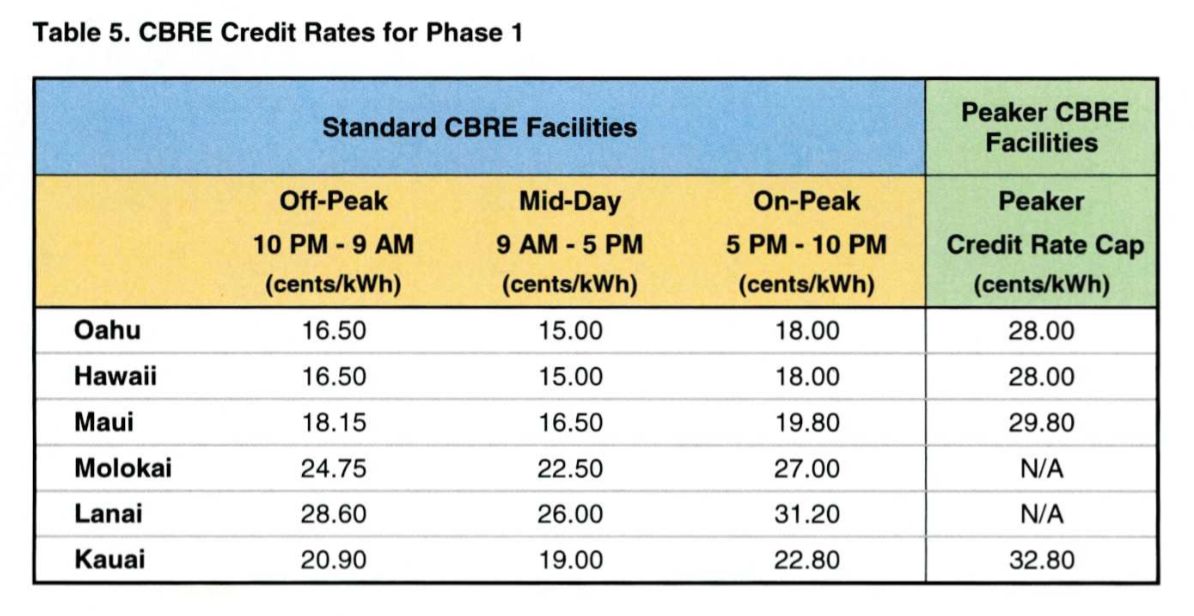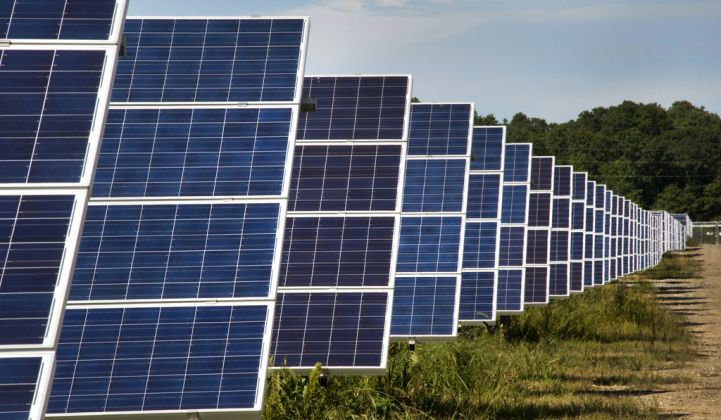Hawaii will move ahead with a first-of-its-kind community renewables program designed to incentivize dispatchable power at times of peak grid demand.
The island state leads the nation in rooftop solar per capita, but many who live there cannot participate in that market. To serve renters, multifamily-housing dwellers, and residents who don’t have a high enough credit score or enough available sun to install their own solar modules, the legislature passed a law mandating that utilities create community renewables programs. The utilities then had to figure out how to add these projects to a grid that already faces saturation by solar over-generation in the middle of the day, with nowhere to export to.
After some fits and starts, the Public Utilities Commission amalgamated the stakeholder viewpoints and filed an order Friday to create shared solar projects that will be compensated differently based on the time of day that they provide power. (To access, search for docket 2015-0389 at the Hawaii PUC website.)
Subscribers to the “Community-Based Renewable Energy” (CBRE) program will earn 20 percent more for power shipped to the grid during the 5 p.m. to 10 p.m. peak hours compared to midday, defined as 9 a.m. to 5 p.m. The off-peak hours from 10 p.m. to 9 a.m. will earn 10 percent more than midday hours. Plants that commit to almost exclusively providing power during peak hours will earn an even higher rate of compensation.
Savvy observers of the sun may notice that it has long since vanished from Hawaii when 10 p.m. rolls around. This pricing isn’t a scheme to trick community solar participants, but an effort to reward dispatchability, which will most likely be provided by pairing energy storage with the solar and wind installations.
Due to the expense of advanced batteries and the still-emerging use cases for them, the additional cost of adding storage to a solar project only pays off in select places. As it happens, Hawaii is one of those places.
The state has to import fossil fuels for conventional electricity generation, which means electricity costs are more there than in any other state, and that solar paired with storage can compete at higher price points than it could on the mainland. Additionally, the proliferation of solar assets on the islands has led to over-generation at midday, meaning new solar projects risk losing revenue to curtailment if they can’t store their energy for use later in the day.
All of which cues Hawaii up for a tantalizing experiment in the distribution of electricity: Can a brand-new community solar program do more than its predecessors in other states? Can it create a market-driven, dispatchable resource that helps the entire grid run more efficiently?
Take a peak
The PUC states in the order that its goal for the shared renewables program is “to create a market-based structure that enables greater customer choice, particularly for those currently unable to participate in onsite distributed generation.” The trick is to do that in a way that adds value to the overall grid rather than imposing costs.
Typically, shared solar projects offer subscriptions with a flat rate of electricity bill credit for each kilowatt-hour produced.
“In jurisdictions with lower amounts of renewable energy, minimal [distributed energy resource] penetration and, consequently, fewer immediate DER integration concerns, this arrangement may be ideal for the conditions,” the order notes.
Given Hawaii’s unique grid dynamics, though, the PUC determined that this approach probably wouldn’t work. Hawaii’s shared renewable program needs to deploy “not just clean energy, but clean energy when the grid demands it.”
Hence the idea to send different price signals based on time of day, originally proposed by the Kauai Island Utility Cooperative and adopted into the docket.
Facilities created under this program will earn more money if they can provide renewable energy when the grid needs more energy, and less money for producing when there’s a surplus of midday solar. Time of day serves as a proxy for demand, but it's a pretty strong proxy that's been adopted by utilities around the country in the form of time-of-use rate structures.
Hawaii's framework also breaks down the project options into three categories: Standard projects, Peaker projects and Utility projects.
Standard projects will be developed, owned and operated by a third party. Peaker projects must deliver 85 percent of monthly output during peak hours, and for their service can earn a higher per-kilowatt-hour “Peaker Credit Rate” during peak hours. This rate is determined during the competitive bidding process and is capped at $0.10 per kilowatt-hour above the on-peak rate. Utility facilities have to provide 75 percent of their capacity to low- or moderate-income customers.
The program will phase in over time, with the first phase lasting two years. There will be 18 megawatts of standard facilities allowed at the outset, with 62 megawatts across the three different types of projects available in the second year.
Phase two will begin after the commission examines the performance of the first phase and makes tweaks as needed.

The latest version of the differential rates based on time of day (Source: Hawaii PUC)
A market for storage?
It’s now up to the utilities and other stakeholders to file comments on the PUC’s plan by March 1. The PUC intends to finalize the framework it laid out here, but will consider any necessary modifications. That means we could see some adjustments, but the bulk of the program should work as described in the order.
Then comes the really intriguing part: seeing how it works in practice.
"This is the first program we’ve seen offering incremental compensation for power produced during peak times," said Jeff Cramer, executive director of the Coalition for Community Solar Access. "We expect that community solar-plus-storage can be done, but this is one of the first opportunities to prove if that business model can work."
Hawaii has more favorable market dynamics for solar paired with storage than most other parts of the country; it could serve as the test case to work out the kinks in a more receptive environment before community solar providers tackle the challenge on the mainland. The key question is whether the program design sends a strong enough market signal for developers to give it a try.
Including batteries in a renewables project adds considerable upfront cost. If the spread between the peak earnings and the midday earnings -- 20 percent, not counting the peaker bonus -- doesn't cover that additional cost, project developers may forget about it and just add more solar to the island grids. That would be a disappointing outcome for the program.
If a few developers give it a go and can offer potential customers much more lucrative bill savings than the solar-only competition, then the market design should stimulate additional storage investment for dispatchable peak power, as new projects fight for consumer attention. That seems to be the favorable outcome the PUC is hoping for.
The differential rates probably won't justify investing in a small amount of storage for a Standard CBRE project, said Ravi Manghani, director of storage at GTM Research. On Oahu, for instance, there's a 3-cent difference in the rates for midday and on-peak. The difference diminishes when you factor in round-trip efficiency losses.
A project developer focusing on the Standard category could sell 100 kilowatt-hours at midday and make $15, or store that energy to sell at the higher rate after 5 p.m. With a 10 percent efficiency loss typical of lithium-ion systems, the output of the batteries would be 90 kilowatt-hours credited at 18 cents per kilowatt-hour, yielding $16.20. That kind of delta is not enough to justify storage at current prices.
"If you look at the peaker premium credit rate, that gets closer to the 15-cent delta that is typically seen as the floor to even consider storage for time-of-use shifting," Manghani said.
The most valuable use of storage, it appears, would be a battery system with the right power/energy ratio to store a full day's solar production and discharge it all within the five hours of the peak, earning the premium peaker rate on every kilowatt-hour produced.
The calculus could change based on local factors and the details of storage pricing. Timing matters too: the peaker option doesn't open up until the program's second year, so battery prices will have some time to come down before then. And there are reasons a storage vendor might want to participate even if the economics aren't ideal.
"Given how aggressive storage developers have been in recent months, with the Aliso Canyon procurements as a case in point, you could see vendors remain that aggressive and bid on these projects," Manghani said. "There is so much interest in the storage market that you almost always see the RFPs being oversubscribed by developers."
The Hawaiian community solar market could be valuable to storage companies trying to deploy their batteries, but which haven't yet broken through in procurement processes. There's a value to real-world deployments with reputable customers, and companies may choose to take an upfront loss to achieve that.
Mass appeal
For this market to take off, it's also crucial that customers actually have an interest in the offerings. The PUC lays out guidelines for the online customer interface that note that ease of use and customer education will play key roles in the launch of the program. If consumers find the program too confusing, they may just put their money elsewhere.
Those project developers need not drag their customers into the complexities of differentials in peak versus off-peak generation; they should be able to calculate that themselves and communicate total savings to customers. Anyone casually browsing the marketplace should see greater savings from projects that deliver peak power.
It's entirely possible that, after some months of run-time, the PUC may need to recalibrate the incentive structure to ensure it achieves the desired policy objectives.
"You’re developing rate structures and rate designs meant to solve myriad policy goals -- that’s a complicated endeavor," said Cramer, director of the Coalition for Community Solar Access. "If they need some tweaks at some point, that’s what happens when you’re the first to do something novel."
If this program achieves its goal, though, it will become a new entrant into the growing array of grid-optimizing renewables policies.
The initial wave of renewable portfolio standards and net energy metering policies rewarded any renewables put on any part of the grid. They succeeded in spurring deployment, but did not maximize the usefulness of that deployment.
More recently, states have tried out methods designed to simultaneously incentivize clean energy and serve other policy objectives. California's NEM 2.0 tariff rewards surplus rooftop solar, but requires that participants switch to a time-of-use tariff, which better reflects the costs of producing grid power at different times. Arizona regulators are mulling a "clean peak standard," which would require a certain amount of peak hour generation come from clean sources.
The community renewables program in Hawaii shares that philosophy of generating market signals not just for clean energy, but for clean energy available when it is most valuable for everybody. Other states eyeing their renewable penetration levels and fretting about the possibility of an emerging duck curve have much to gain from this approach.



